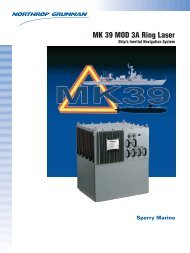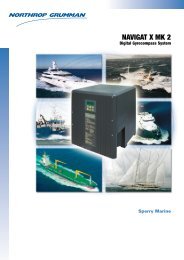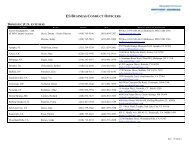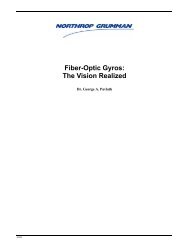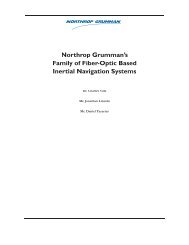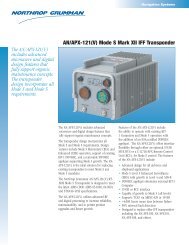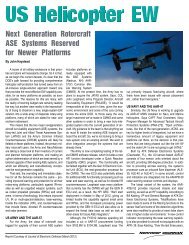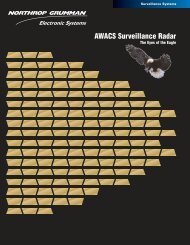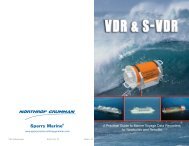Central IFF System AN/UPX-24(V) - Northrop Grumman Electronic ...
Central IFF System AN/UPX-24(V) - Northrop Grumman Electronic ...
Central IFF System AN/UPX-24(V) - Northrop Grumman Electronic ...
Create successful ePaper yourself
Turn your PDF publications into a flip-book with our unique Google optimized e-Paper software.
<strong>Central</strong><br />
<strong>IFF</strong> <strong>System</strong><br />
<strong>AN</strong>/<strong>UPX</strong>-<strong>24</strong>(V)<br />
OVERVIEW<br />
<strong>Northrop</strong> <strong>Grumman</strong>'s Interrogator Set<br />
<strong>AN</strong>/<strong>UPX</strong>-<strong>24</strong>(V) is the core Identification Friend<br />
or Foe (<strong>IFF</strong>) processor of the shipboard<br />
Interrogator <strong>System</strong> <strong>AN</strong>/<strong>UPX</strong>-29(V), a<br />
technologically sophisticated cooperative<br />
identification system for naval shipboard use.<br />
The <strong>AN</strong>/<strong>UPX</strong>-<strong>24</strong>(V) identifies aircraft and<br />
surface platforms equipped with Selective<br />
Identification Feature (SIF) Modes 1, 2, 3A, and<br />
C, and provides secure, positive identification of<br />
cooperative Mode 4 targets. The <strong>IFF</strong> data from<br />
one <strong>AN</strong>/<strong>UPX</strong>-<strong>24</strong>(V) can be synchronized with<br />
up to four individual radars, eliminating the<br />
expense of separate, dedicated <strong>IFF</strong> systems for<br />
each radar and reducing problems caused by<br />
over-interrogation. It provides the operator with<br />
synthetic <strong>IFF</strong> symbology, which aids in target<br />
recognition and tracking.<br />
The <strong>AN</strong>/<strong>UPX</strong>-<strong>24</strong>(V) operates with an<br />
<strong>Electronic</strong>ally Steerable Antenna (ESA), the<br />
OE-120( )/<strong>UPX</strong>, which can instantaneously be<br />
redirected to interrogate a target at any<br />
azimuth in less than 50 microseconds. The<br />
system operates with radar rotation rates of up<br />
to 60 RPM and can also be configured<br />
to operate with a mechanically rotating<br />
<strong>IFF</strong> antenna.<br />
Since 1979, <strong>Northrop</strong> <strong>Grumman</strong> has been<br />
supplying the <strong>AN</strong>/<strong>UPX</strong>-<strong>24</strong>(V) for the CG 47<br />
“Ticonderoga” Class Aegis cruisers, the DDG 51<br />
“Arleigh Burke” Class Aegis destroyers, the LHD<br />
I "Wasp" Class, the LPD 17 “San Antonio” Class<br />
amphibious assault ships, and the CVN 68<br />
“Nimitz” Class carriers.<br />
SYSTEM EQUIPMENT<br />
The <strong>AN</strong>/<strong>UPX</strong>-<strong>24</strong>(V) consists of a Processor-<br />
Controller (PC), a Control Monitor (CM), and<br />
up to 22 Control Indicators (CIs).<br />
Processor-Controller<br />
The PC receives mode selection and<br />
interrogation commands from both operator<br />
actions at the CIs and via the Naval Tactical<br />
Data <strong>System</strong> (NTDS) MIL-STD-1397 combat<br />
system interface. The PC sends steering<br />
commands to the OE-120( )/<strong>UPX</strong> ESA antenna<br />
and interrogation commands to the <strong>AN</strong>/<strong>UPX</strong>-27<br />
or the <strong>AN</strong>/<strong>UPX</strong>-37 interrogator. It receives <strong>IFF</strong><br />
video and mode tags from the <strong>AN</strong>/<strong>UPX</strong>-27 or<br />
the <strong>AN</strong>/<strong>UPX</strong>-37 and performs target detection,<br />
decoding, code validation, defruiting, and<br />
degarbling, using established criteria for target<br />
start, continuation, end, verification, and<br />
code validation.<br />
Control Monitor<br />
The CM allows the user to define up to three<br />
manually entered azimuth sectors with<br />
individual control of interrogation modes, pulse<br />
repetition frequency, and radio frequency power.<br />
It also provides remote alarms, PC master reset,<br />
NTDS minimum/maximum range control, and<br />
Mode 4 control and crypto zeroize.<br />
Control Indicators<br />
The Cls are colocated with Planned Position<br />
Indicators or NTDS consoles. They enable the<br />
console operators to interrogate selected modes<br />
and to request active and popup evaluation of<br />
both SIF and Mode 4 targets. They allow passive<br />
decode of operator selected targets, which<br />
provides unique target symbology to be<br />
displayed for targets of operator interest.<br />
FUNCTIONAL DESCRIPTION<br />
The shipboard weapon system can request<br />
modes of interrogation and all target<br />
information from full scans or in specified<br />
sectors of a scan, test targets at specified range<br />
and azimuth, and popup target information in<br />
a range-azimuth window centered at a specified<br />
point. The <strong>AN</strong>/<strong>UPX</strong>-<strong>24</strong>(V) provides target<br />
reports to the combat data system.<br />
The <strong>AN</strong>/<strong>UPX</strong>-<strong>24</strong>(V) operates in two modes: popup<br />
or sector. Popup and sector mode processing<br />
can be performed simultaneously without<br />
degradation.<br />
In response to a popup request, when using the<br />
ESA, the PC immediately redirects to interrogate<br />
an area of interest. This permits immediate<br />
acquisition of <strong>IFF</strong> data relative to a specified<br />
target or area.<br />
Sector mode operates with either antenna type.<br />
In response to a sector request, the <strong>AN</strong>/<strong>UPX</strong>-<br />
<strong>24</strong>(V) waits until the antenna rotates the ESA to<br />
the area of interest before data is required.<br />
In fruit environments of 5000/second and<br />
greater, the <strong>AN</strong>/<strong>UPX</strong>-<strong>24</strong>(V) performs defruiting,<br />
degarbling, and decoding significantly better<br />
than any other available system. The <strong>AN</strong>/<strong>UPX</strong>-<br />
<strong>24</strong>(V) has online fault detection, self-fault<br />
isolation, and a fully redundant unit with<br />
automatic switchover capability.<br />
<strong>AN</strong>/<strong>UPX</strong>-<strong>24</strong>(V) SYSTEM FEATURES<br />
� 40k steady-state defruiter<br />
� l00k peak defruiter<br />
� 100 target simultaneous processing capability<br />
during any sweep<br />
� Separate processing files<br />
for active and popup processing<br />
� Jittered pulse-repetition-time capability<br />
� Full sweep and window-gated Mode 4<br />
evaluation in override and interface modes<br />
� Targets-per-antenna scan limited to 10<strong>24</strong><br />
targets-per-sweep<br />
� Detection and recombination of target splits in<br />
range and/or azimuth<br />
� Effective separation of targets at the same<br />
range which overlap in azimuth<br />
� Centroided azimuth<br />
� High-resolution range<br />
� lndication-of-position and military/civilian<br />
emergency detection<br />
� Primary power: 115 Vac 10%<br />
60-400 HZ<br />
1500 W max<br />
� Weight: 868 Ib appx. (393.7 kg)<br />
� Dimensions: height 72 in. (182.9 cm)<br />
width 36 in. (91.4 cm)<br />
depth 29 in. (73.7 cm)<br />
� Military specifications:<br />
Shock: MIL-S-901<br />
General: MIL-E-16400<br />
Vibration: MIL-STD-167<br />
EMI: MIL-STD-461<br />
Noise: MIL-STD-740<br />
� Distributed processing architecture



